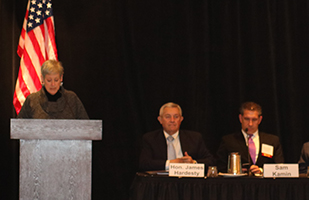Chief Justice Addresses Opioid Epidemic at Nevada Conference

Ohio Supreme Court Chief Justice Maureen O'Connor addresses the Conference of Chief Justices in Henderson, Nev. Seated from left are Nevada Supreme Court Justice James Hardesty and Sam Kamin, professor at the University of Denver Sturm College of Law.

Ohio Supreme Court Chief Justice Maureen O'Connor addresses the Conference of Chief Justices in Henderson, Nev. Seated from left are Nevada Supreme Court Justice James Hardesty and Sam Kamin, professor at the University of Denver Sturm College of Law.
With an average of 12 Ohioans dying each day of drug overdoses, Ohio Supreme Court Chief Justice Maureen O’Connor addressed the Conference of Chief Justices (CCJ) in Henderson, Nevada, this week to talk about the fight from a legal perspective.
The topic was the “The Brain Science of Addiction” and panelists addressed how jurisdictions are grappling with the onslaught of drug cases pouring through the justice system.
“We’ve seen evil innovation at work in the recent past, with carfentanil hitting the street at thousands of times the strength of fentanyl,” said Chief Justice O’Connor, who serves as the CCJ’s president. “To combat that kind of innovation, the moving target of the drug scene, we decided to embark on some innovation of our own.”
That innovation exists in the creation of the Regional Judicial Opioid Initiative, or RJOI, which is a first-of-its-kind regional task force.
Eight states — Illinois, Indiana, Kentucky, Ohio, Michigan, North Carolina, Tennessee, and West Virginia — have started to identify the core problems and split up the work.
“One of our earliest targets, and a point of ongoing success right now, was prescription drug monitoring,” said Chief Justice O’Connor. “Allowing each state to remain an island was no way to solve doctor shopping and pharmacy shopping. We knew we had to work across borders, and we are.”
Panelists also discussed the latest research on treatment options and evidence-based sentencing.


